Are you trying to understand Harakat in Arabic?
These little marks – also called Arabic diacritics or vowel signs – are key to reading Arabic the right way.
If you’re learning Quranic Arabic or want to improve your Tajweed pronunciation, then mastering Arabic Harakat rules is one of the first things to focus on.
In this beginner-friendly guide, you’ll explore:
- What Harakat are and how they shape Arabic pronunciation
- The three main short vowels in Arabic: Fatha, Damma, and Kasra
- How Tanween and Madd work in the Quran
- And how to read Arabic with Harakat step by step
We’ll also talk about things like the difference between Harakat and Tashkeel. Let’s keep it simple and take it one step at a time.
Note: If you’re still working on your Arabic alphabet pronunciation, check out our earlier lesson. It’s a great way to build a strong foundation before moving forward.
What is Harakat in Arabic?
If you’re new to Arabic, you’ve probably seen small marks placed above or below the letters. These are called Harakat – and they’re super important.
Harakat in Arabic are short vowel marks that help you pronounce words correctly. They guide your Arabic pronunciation, especially when reading the Quran or learning Tajweed.
Without Harakat, it’s tough to know how a word should sound.
There are three main Harakat or Arabic vowel marks you’ll see:
- Fatha ( ـَ ) – gives a short “a” sound
- Damma ( ـُ ) – gives a short “u” sound
- Kasra ( ـِ ) – gives a short “i” or “ee” sound
These marks are part of a system called Tashkeel, which refers to all the Arabic diacritics used to guide how a word is read. Mastering these is the first step toward fluent Quranic Arabic pronunciation.
Let’s look at each one:
Fatha – The “A” Sound
Fatha is a small slanted line placed above a letter. It tells you to make a short “a” sound – like “Ba” in Balloon.
For example:
- بَ = Ba
- لَ = La
- حَ = Ha
Tip: Try saying these out loud. You’ll feel the open “a” sound right away.
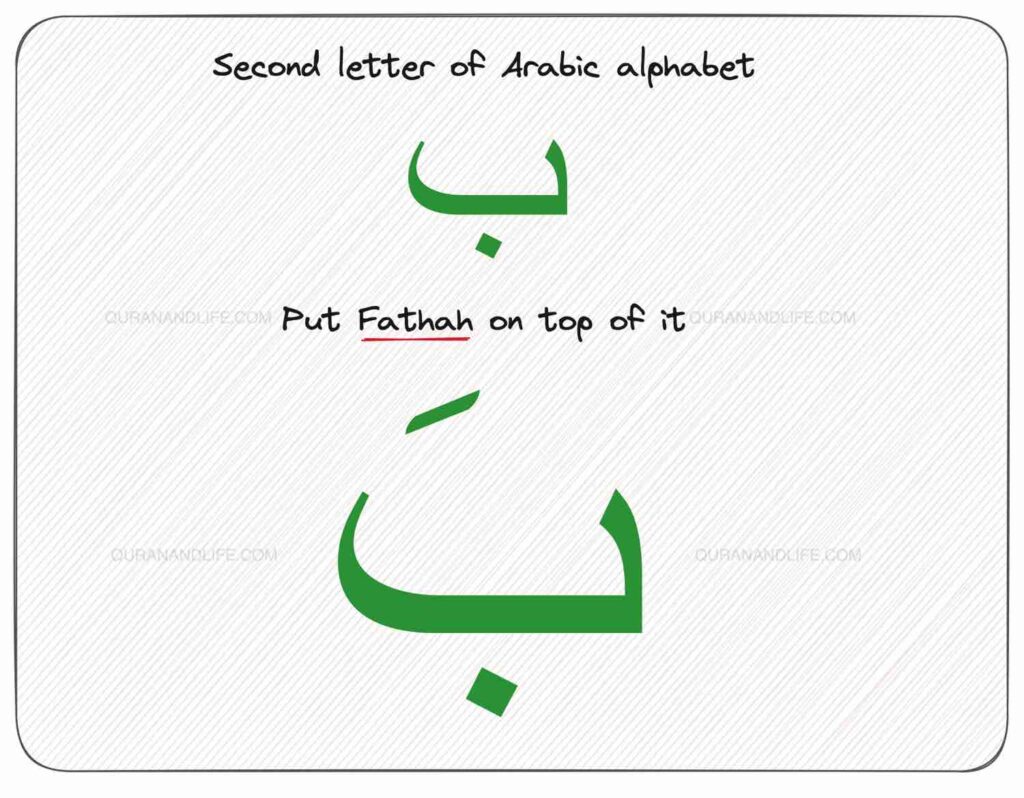
Let’s take a look at a few more letters:
| Equivalent sound in English | Arabic letters with Fathah |
| “La” as in Lala | لَ |
| “Ha” as in Half | حَ |
| “Pa” as in Pasta | پَ |
Damma – The “U” Sound
Damma looks like a small curl or mini “w” above the letter. It gives you the short “u” sound, like “Boo” in Boom.
Here are some examples:
- بُ = Boo
- زُ = Zoo
- فُ = Foo
Damma is one of the most distinct short vowels in Arabic, and once you hear it, you’ll never forget the sound.
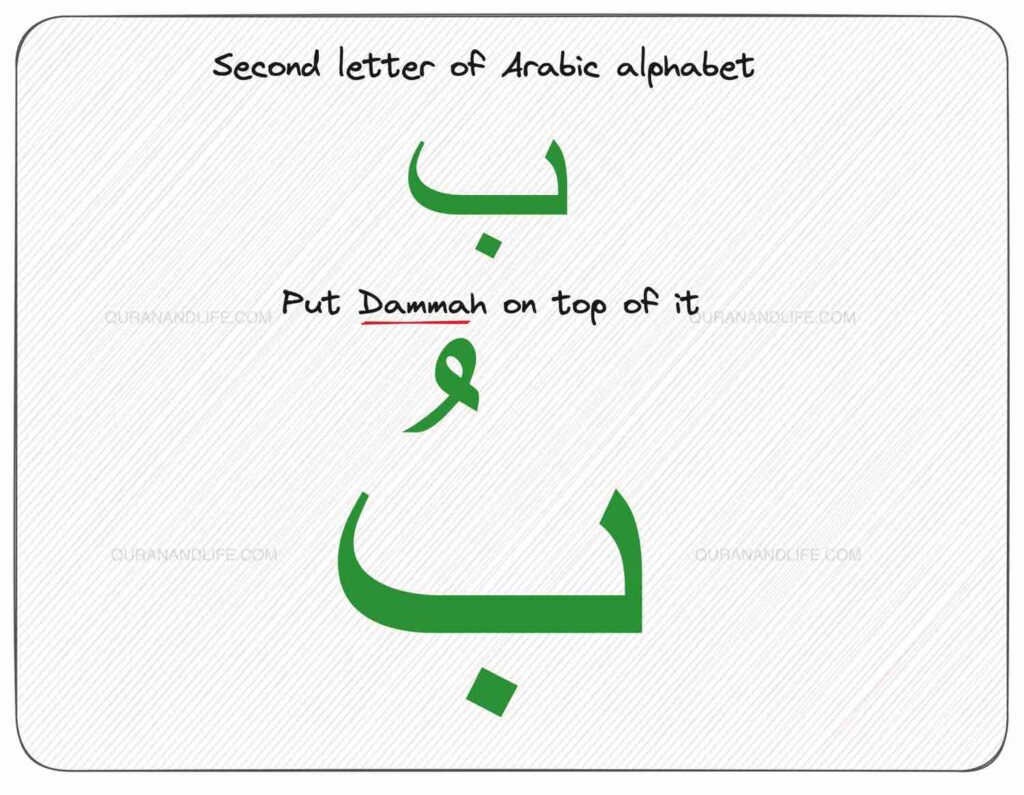
Here are a few more Arabic letters with Dammah on them:
| Equivalent sound in English | Arabic letters with Dammah |
| Zoo | زُ |
| Foo | فُ |
Kasra – The “e” Sound
Kasra is a small line placed under a letter. It produces a short “i” or “ee” sound – just like “Be” in Bee.
Let’s try a few:
- بِ = Be
- جِ = Je
- سِ = Si
You’ll often see Kasra used when teaching beginners the basics of Arabic letter pronunciation.
This image shows how we put Kasrah under the letter.
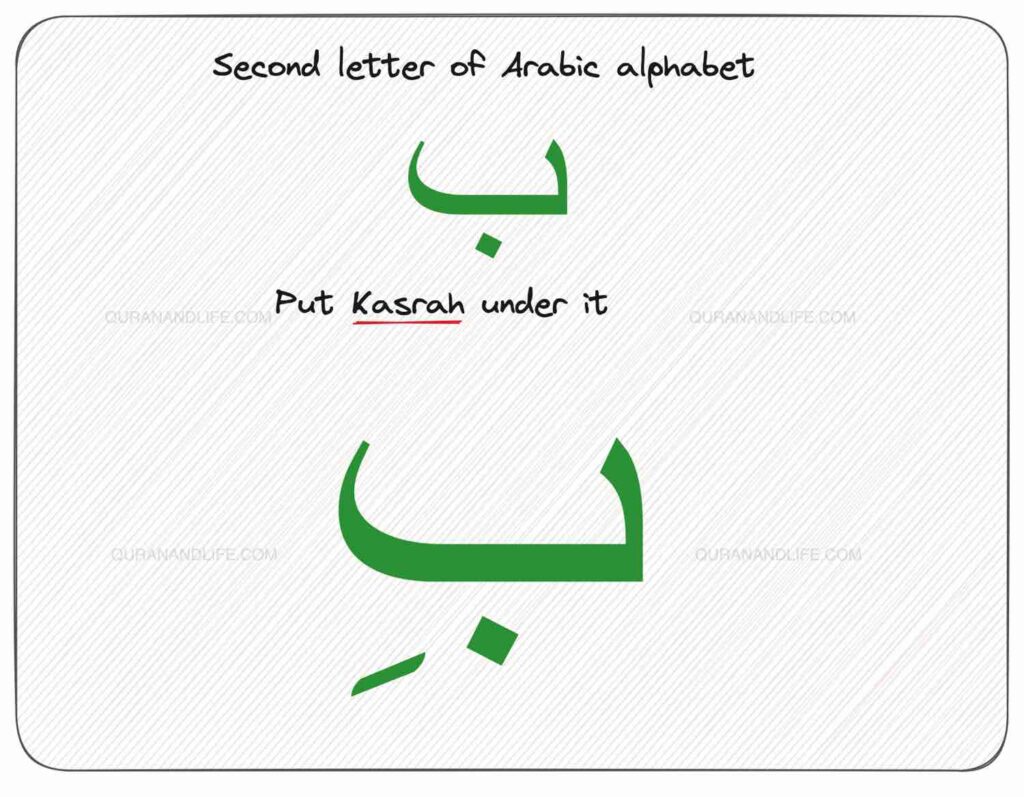
Here are a few more words that ends with an “e” sound:
- She
- He
- Flee
- Agree
| Equivalent sound in English | Arabic letters with Kasrah |
| Be | بِ |
| Je | جِ |
Applying Harakat in Arabic Words
Let’s see how Harakat can completely change the sound of a letter. Take the Arabic letter س (Seen) for example:
| Salmon | سَ |
| Seen | سِ |
| Suzan | سُ |
Even though it’s the same letter, adding different Harakat in Arabic changes the sound and meaning.
Just like in English – mad and made sound and mean different things because of the vowel.
That’s the power of Arabic short vowels.
Bonus: Harakat vs Tashkeel
Many learners ask: What’s the difference between Harakat and Tashkeel?
Harakat are a subset of Tashkeel, which includes all diacritical marks used in Arabic – like Shadda, Sukun, and Tanween.
So all Harakat are Tashkeel, but not all Tashkeel are Harakat.
What is Tanween in Arabic?
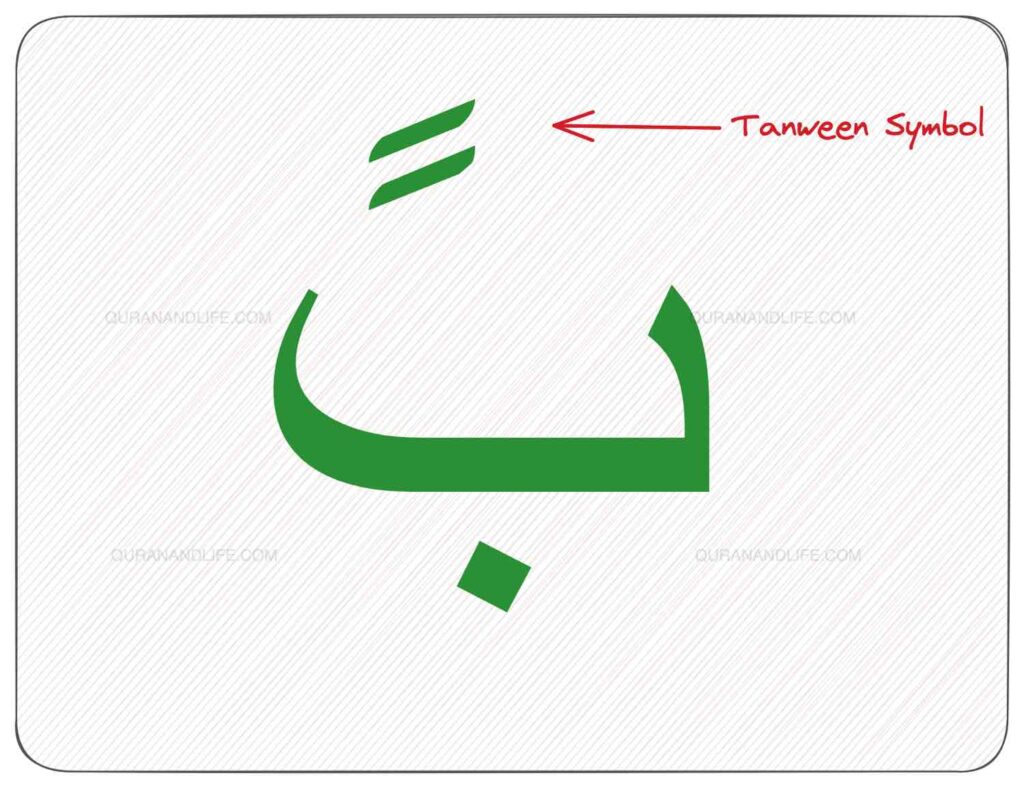
Ever wondered how to create sounds like “sun,” “run,” or “win” while reading the Quran?
That’s where Tanween comes in.
Tanween is a special form of Harakat in Arabic. It adds a soft “n” sound to the end of a word—just like what you hear in words like “sun” or “win.”
There are three types of Tanween:
- Tanween Fathah → سً (sounds like “sun”)
- Tanween Dammah → سٌ (sounds like “soon”)
- Tanween Kasrah → سٍ (sounds like “sin”)
You can think of Tanween as a double version of the short vowels.
Instead of one Harakah, you’ll see two – either above or below the letter.
Here’s a simple example from real Quranic Arabic. You’ll notice Tanween clearly in Ayah 5 of Surah Al-Falaq.
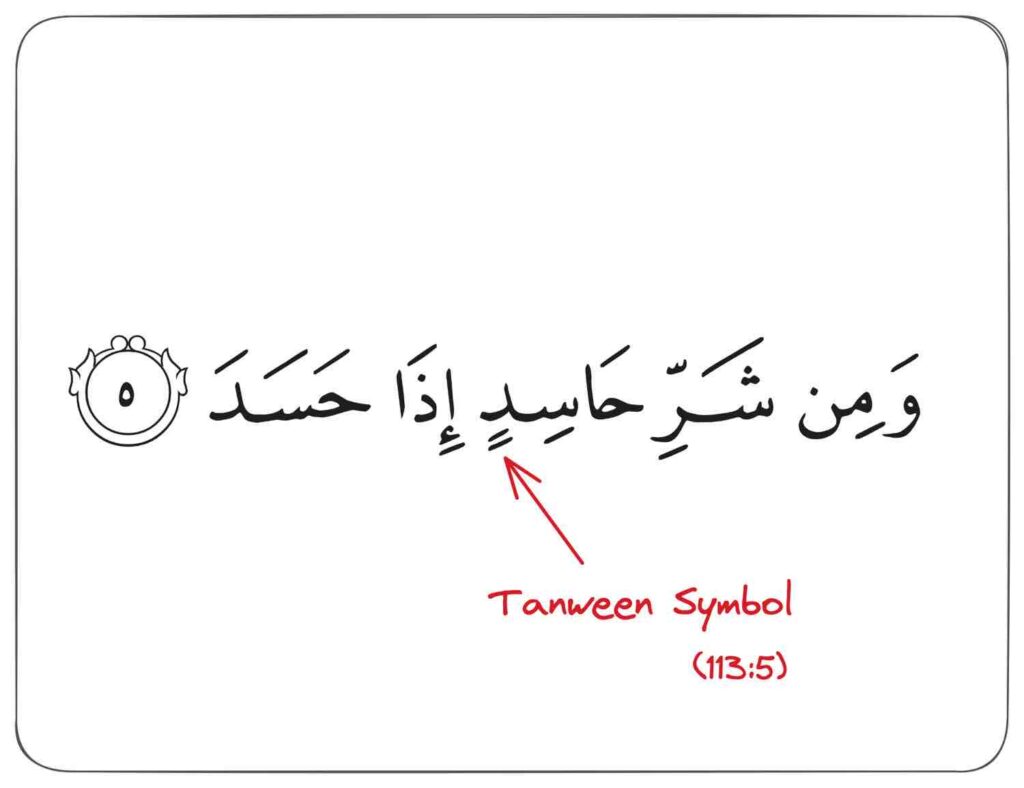
Let’s look at more examples to make it easier:
| Tanween | Harakat |
| بً | بَ |
| بٌ | بُ |
| بٍ | بِ |
Here are some English words that produce similar sound as Arabic letters with Tanween on them.
| English Word | Tanween Letter |
| Sun | سً |
| Run | رً |
| Boon | بٌ |
| Soon | سٌ |
| Win | وٍ |
| Kin | كٍ |
What is Madd in Arabic?
Madd means to stretch or extend a sound in Arabic.
It’s an important part of Tajweed rules and helps make your Quranic Arabic pronunciation smooth and accurate.
We usually create Madd by using long vowels like:
- Alif (ا)
- Waw (و)
- Ya (ي)
Earlier, you learned how Fathah, Kasrah, and Dammah add short vowel sounds to Arabic letters.
Each of these short sounds lasts for one unit of time – what we call one Harakah.
To help you visualize it, think of Harakah like any measurement: 1 gram, 1 millimeter, or 1 inch.
But what if you need to stretch the sound longer?
That’s where Madd comes in.
Let’s say:
- 1 Harakah + 1 Harakah = Madd
- It gives the letter a natural elongation
Here’s a quick look at how Madd in Arabic is measured:
| Stretch Length | Type of Madd | Description |
| 1 Harakah | Not a Madd | Just a regular short vowel |
| 2 Harakats | Madd Tabeeiy | Natural Madd (most common) |
| 4 Harakats | Madd Munttassil | Extended Madd |
| 6 Harakats | Extra Long Madd | Rare, used in special cases |
Note: We’ll explore extra-long Madd in a separate lesson, so don’t worry about it now.
How to Apply Madd (Madd Tabeeiy)
Now that you know what Madd is, let’s talk about the most common type – Madd Tabeeiy, also called natural Madd.
This type of Madd simply stretches a sound for the length of two Harakats (short vowel units). It’s easy to do once you get the hang of it.
So, how do you apply Madd?
You use one of the three long vowels in Arabic:
- Alif (ا) for the “aa” sound
- Waw (و) for the “oo” sound
- Ya (ي) for the “ee” sound
But here’s the rule:
You combine a short vowel (Fathah, Dammah, or Kasrah) with a matching long vowel.
Let’s break it down with simple examples:
| Short Sound (1 Harakah) | Add Long Vowel | Result (2 Harakats Madd) |
| بَ (Ba-Fathah) | + ا (Alif) | بَا (Baa) |
| بُ (Bu-Dammah) | + و (Waw) | بُو (Boo) |
| بِ (Bi-Kasrah) | + ي (Ya) | بِی (Bee) |
So instead of a short, quick sound like “Ba”, you now stretch it to “Baa” – twice as long.
This is the essence of Madd Tabeeiy in Arabic pronunciation.
When you’re reading Quran or practicing Tajweed, this small adjustment in stretching the sound makes a big difference in fluency and correctness.
Ready to learn how Madd can stretch even further?
Let’s move on to the longer types of Madd like Madd Munttassil.
What is Madd Ele’yeen?
Madd Ele’yeen is another type of Madd in Arabic – but it’s a bit different from the natural Madd (Madd Tabeeiy) you just learned.
While natural Madd stretches a letter’s sound with full clarity and strength, Madd Ele’yeen is softer and weaker. It’s like a gentle stretch that’s not as prominent.
This type of Madd happens when:
- A letter ends with a Sukoon ^
- And that letter is Waw (و) or Ya (ي), and it’s preceded by a letter with a Dammah or a Kasrah
So it doesn’t feel like a full vowel stretch but still extends the sound slightly – just enough to flow smoothly.
We’ll go deeper into Madd Ele’yeen in upcoming lessons, but for now, just remember:
It’s a milder form of vowel elongation used in certain recitations, especially in Quranic Arabic.
Want to see how long vowel sounds can stretch even further?
Let’s move to the next type: Madd Munttassil.
Madd Munttassil – Longer Stretch with Hamza
Sometimes, a regular two-count stretch just isn’t enough. That’s when Madd Munttassil comes in.
In Arabic Tajweed, Madd Munttassil happens when a Hamza (ء) comes right after a natural Madd (like بَا, جُو, or جِي). This combination allows you to extend the sound for four Harakat instead of just two.
This longer stretch helps you recite certain Quranic words correctly, especially during Quranic Arabic pronunciation where precision matters.
Let’s compare the stretch lengths using examples:
| Stretch Type | Example Word | Arabic |
| Single Harakat | Ja | جَ |
| Double Stretch | Jaa | جَا |
| Four Harakat | Jaa’ | جَاء |
| Ji | جِ | |
| Double Stretch | Jii | جِى |
| Four Harakat | Jii’ | جِىء |
| Ju | جُ | |
| Double Stretch | Juu | جُو |
| Four Harakat | Juu’ | جُوء |
This longer Madd is called Madd Munttassil, and it usually appears within the same word (Munttassil means “connected”).
There’s also a similar type called Madd Munfasil, where the Madd and Hamza fall in separate words. Both typically stretch for four Harakat, so their application is nearly the same during recitation.
Tip: Think of Madd Munttassil as an intensifier – when you see a Hamza after a stretched sound, give it a little more time while reciting, just as you would pause slightly longer when emphasizing a word in English.
FAQ: More About Harakat in Arabic
Q: How many Harakat are there in Arabic?
A: There are three main short vowels – Fathah, Dammah, and Kasrah—and other diacritics like Sukun, Shadda, and Tanween.
Q: What’s the difference between Harakat and Tashkeel?
A: Harakat are the short vowels, while Tashkeel is a broader term that includes all diacritics like Shadda (emphasis) and Sukun (no vowel).
Q: Why are Harakat important in Quranic recitation?
A: They help preserve the exact pronunciation of every word in the Quran. A missing or wrong Harakah can change the meaning.
Q: What are Arabic diacritical marks used for?
A: They guide pronunciation, especially for beginners, and help you read Arabic accurately.
Q: How can I type Arabic with Harakat on a keyboard?
A: Most keyboards allow this with Shift+key combos. For example, Shift+Q for Fathah, Shift+E for Dammah, etc. You can also enable the Arabic keyboard with Harakat in your language settings.
Q: What’s the best way to study Arabic Harakat?
A: Start with the basics using free resources or apps, then practice by reading Quranic verses with full Tashkeel. Enrolling in a Tajweed course can also help.




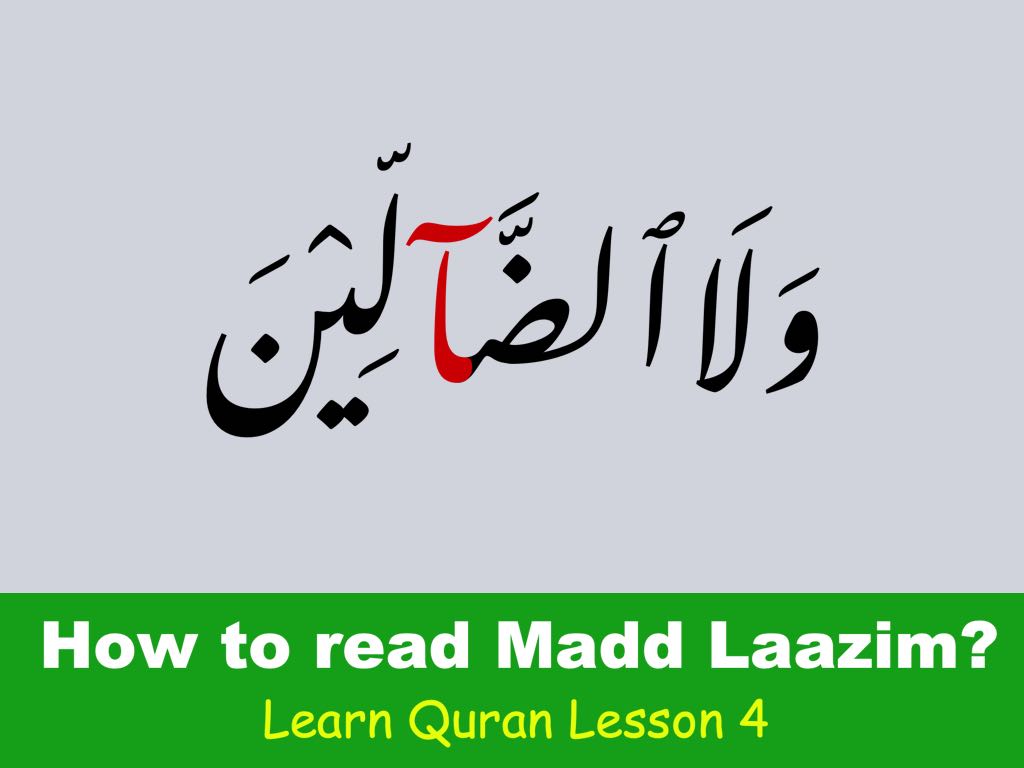
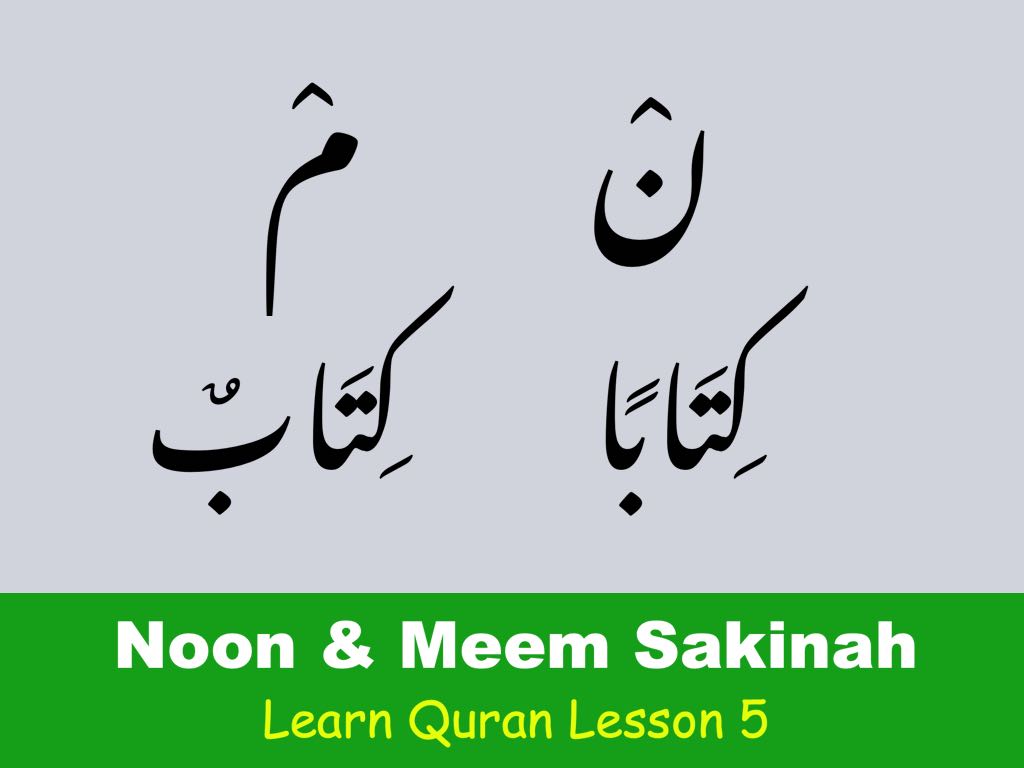
Maa Shaa Allah
السلام عليكم
الله همبارك.
Ma Sha Allah.
Alhamdulillah!